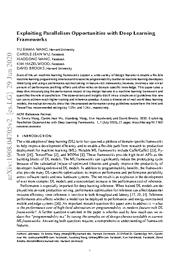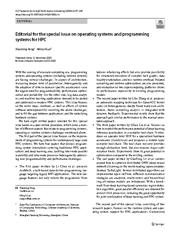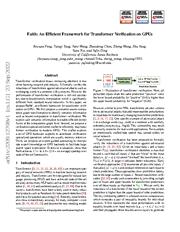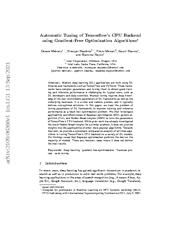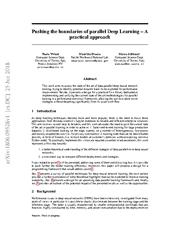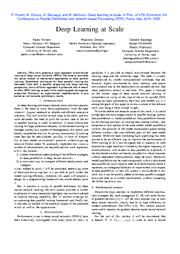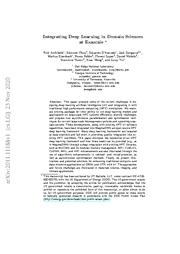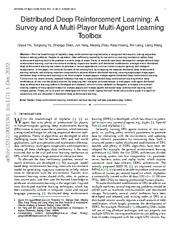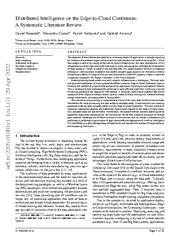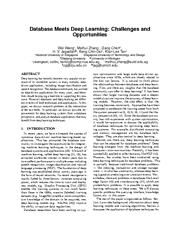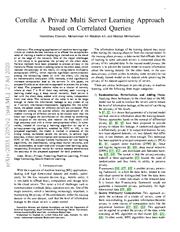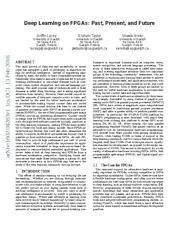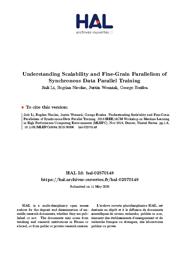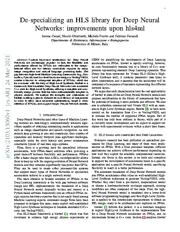A copy of this work was available on the public web and has been preserved in the Wayback Machine. The capture dates from 2020; you can also visit the original URL.
The file type is application/pdf.
Filters
Exploiting Parallelism Opportunities with Deep Learning Frameworks
[article]
2020
arXiv
pre-print
This paper takes a deep dive into analyzing the performance impact of key design features in a machine learning framework and quantifies the role of parallelism. ...
State-of-the-art machine learning frameworks support a wide variety of design features to enable a flexible machine learning programming interface and to ease the programmability burden on machine learning ...
In this section, we describe how deep learning framework design choices (Section 2.1) exploit parallelism opportunities exposed in deep learning workloads (Section 2.2), and overview our framework parameter ...
arXiv:1908.04705v2
fatcat:fnmcly3f3vanvlc6hi6uxxj6pi
Editorial for the special issue on operating systems and programming systems for HPC
2020
CCF Transactions on High Performance Computing
With a benchmark from deep learning-based cancerous region detection algorithm, good parallel efficiency are obtained for at most 1024 processors, revealing the great opportunity for joint combination ...
of deep learning and HPC system. ...
With a benchmark from deep learning-based cancerous region detection algorithm, good parallel efficiency are obtained for at most 1024 processors, revealing the great opportunity for joint combination ...
doi:10.1007/s42514-020-00053-6
fatcat:nthaiyn6m5eqvisdxwiz7r7u2m
HOTI 2020 Commentary
2020
2020 IEEE Symposium on High-Performance Interconnects (HOTI)
The recent advances in Deep Learning (DL) has led to many exciting challenges and opportunities for CS and AI researchers alike. ...
We will also present an overview of different DNN architectures and DL frameworks. Most DL frameworks started with a single-node design. ...
His research interests include parallel computer architecture, high performance networking, InfiniBand, network-based computing, exascale computing, programming models, GPUs and accelerators, high performance ...
doi:10.1109/hoti51249.2020.00012
fatcat:ptxu3fuk5vghflln7ezaitoeyq
Faith: An Efficient Framework for Transformer Verification on GPUs
[article]
2022
arXiv
pre-print
Transformer verification draws increasing attention in machine learning research and industry. ...
It formally verifies the robustness of transformers against adversarial attacks such as exchanging words in a sentence with synonyms. ...
Deep Learning Frameworks on GPUs GPUs have been widely exploited to accelerate deep learning workload [13, 39, 40, 46, 49] . ...
arXiv:2209.12708v1
fatcat:xe5aatchkvc7xdyd4btbc4ci2q
Automatic Tuning of Tensorflow's CPU Backend using Gradient-Free Optimization Algorithms
[article]
2021
arXiv
pre-print
Modern deep learning (DL) applications are built using DL libraries and frameworks such as TensorFlow and PyTorch. ...
Manual tuning requires deep knowledge of the user-controllable parameters of DL frameworks as well as the underlying hardware. ...
The availability of open-source deep learning software frameworks, such as PyTorch [11] and TensorFlow [1] , along with the suites of neural network models [15] enables fast deployment of deep learning ...
arXiv:2109.06266v1
fatcat:ixszcn5fo5dmfn442e33k34a7q
Pushing the boundaries of parallel Deep Learning -- A practical approach
[article]
2018
arXiv
pre-print
This work aims to assess the state of the art of data parallel deep neural network training, trying to identify potential research tracks to be exploited for performance improvement. ...
Beside, it presents a design for a practical C++ library dedicated at implementing and unifying the current state of the art methodologies for parallel training in a performance-conscious framework, allowing ...
In order to provide a truly general purpose tool, as well as to exploit the peculiarities of the different deep learning frameworks available, the proposed FAST (Flexible (A)synchronous Scalable Training ...
arXiv:1806.09528v1
fatcat:hakyhxanivfmfnqkgnyjlycsie
Deep Learning at Scale
2019
2019 27th Euromicro International Conference on Parallel, Distributed and Network-Based Processing (PDP)
Established techniques for data parallel training are discussed from both a parallel computing and deep learning perspective, then a different approach is presented that is meant to allow DNN training ...
This work presents a novel approach to distributed training of deep neural networks (DNNs) that aims to overcome the issues related to mainstream approaches to data parallel training. ...
In order to provide a truly general purpose tool, as well as to exploit the peculiarities of the different deep learning frameworks available, the proposed FAST (Flexible (A)synchronous Scalable Training ...
doi:10.1109/empdp.2019.8671552
dblp:conf/pdp/VivianiDBCA19
fatcat:cf7wan67i5f63oipufn77r2pxi
Integrating Deep Learning in Domain Sciences at Exascale
[article]
2020
arXiv
pre-print
These developments, along with existing HPC AI software capabilities, have been integrated into MagmaDNN, an open-source HPC deep learning framework. ...
This paper discusses the necessities of an HPC deep learning framework and how those needs can be provided (e.g., as in MagmaDNN) through a deep integration with existing HPC libraries, such as MAGMA and ...
Applications
Materials Science and Microscopy There are multiple opportunities to exploit machine learning techniques in materials science. ...
arXiv:2011.11188v1
fatcat:zhmnfvhvbjhjzj72tu6ikrcpla
Distributed Deep Reinforcement Learning: A Survey and A Multi-Player Multi-Agent Learning Toolbox
[article]
2022
arXiv
pre-print
With the breakthrough of AlphaGo, deep reinforcement learning becomes a recognized technique for solving sequential decision-making problems. ...
learning, covering single player single agent distributed deep reinforcement learning to the most complex multiple players multiple agents distributed deep reinforcement learning. ...
Due to the structured computation pattern of deep learning algorithms, some successful distributed learning methods are proposed for parallelism in deep learning [20] , [21] . ...
arXiv:2212.00253v1
fatcat:2gymorseene2dezdgny5fddyde
Distributed Intelligence on the Edge-to-Cloud Continuum: A Systematic Literature Review
2022
Journal of Parallel and Distributed Computing
This is necessary to help understand the performance trade-offs that result from combining a variety of learning paradigms and supportive frameworks. ...
It describes the main learning paradigms enabling learning-based analytics on the Edge-to-Cloud Continuum. ...
Marked with a ⋆ are the mostly exploited in the experiments. Framework/Library Qty. ...
doi:10.1016/j.jpdc.2022.04.004
fatcat:mopdegh4vrgt5k47vrmc7xum24
Database Meets Deep Learning
2016
SIGMOD record
In particular, we discuss possible improvements for deep learning systems from a database perspective, and analyze database applications that may benefit from deep learning techniques. ...
Deep learning has recently become very popular on account of its incredible success in many complex data-driven applications, such as image classification and speech recognition. ...
With the advancements of deep learning models in NLP [13] , it is opportune to consider deep learning for these problems. ...
doi:10.1145/3003665.3003669
fatcat:erig6kfsk5c3jmxintphi5fzl4
Corella: A Private Multi Server Learning Approach based on Correlated Queries
[article]
2020
arXiv
pre-print
The proposed scheme relies on a cluster of servers, where at most T ∈N of them may collude, each running a learning model (e.g., a deep neural network). ...
Simulation results for various datasets demonstrate the accuracy of the proposed approach for the classification, using deep neural networks, and the autoencoder, as supervised and unsupervised learning ...
Indeed, the system gradually learns to exploit this opportunity during the training phase. ...
arXiv:2003.12052v2
fatcat:zbmbcjsln5d3xjynwtckdlg5sa
Deep Learning on FPGAs: Past, Present, and Future
[article]
2016
arXiv
pre-print
Current trends in design tools for FPGAs have made them more compatible with the high-level software practices typically practiced in the deep learning community, making FPGAs more accessible to those ...
how FPGAs may best serve the needs of the deep learning community moving forward. ...
They are also capable of exploiting distributed on-chip memory, as well as large degrees of pipeline parallelism, which fit naturally with the feed-forward nature deep learning methods. ...
arXiv:1602.04283v1
fatcat:xffu7dm7ifbxjir7ivskhxozyi
Understanding Scalability and Fine-Grain Parallelism of Synchronous Data Parallel Training
2019
2019 IEEE/ACM Workshop on Machine Learning in High Performance Computing Environments (MLHPC)
Index Terms-deep learning, data-parallel training, behavior analysis ...
In the age of big data, deep learning has emerged as a powerful tool to extract insight and exploit its value, both in industry and scientific applications. ...
Thanks to this ease-of-use, Horovod is one of the most widely used synchronous deep learning frameworks. ...
doi:10.1109/mlhpc49564.2019.00006
dblp:conf/sc/LiNWB19
fatcat:pcxwhll7xncrdp2m652gpx323u
De-specializing an HLS library for Deep Neural Networks: improvements upon hls4ml
[article]
2021
arXiv
pre-print
with the help of High-Level Synthesis. hls4ml is a framework that translates Deep Neural Networks into annotated C++ code for High-Level Synthesis, offering a complete and user-friendly design process ...
The gap between high-level Machine Learning frameworks (e.g., Tensorflow, Pytorch) and low-level hardware design in Verilog/VHDL creates a barrier to widespread adoption of FPGAs, which can be overcome ...
HLS TOOLS AND COMPILERS FOR DEEP LEARNING Extensive research has been published on specialized processors for Deep Learning, and many of them were implemented on FPGA. ...
arXiv:2103.13060v1
fatcat:pjcfqysla5fsdlggstud5rgxby
« Previous
Showing results 1 — 15 out of 72,296 results

